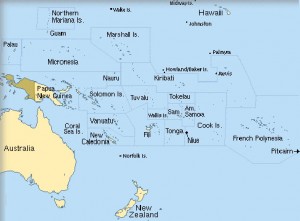Tonga is noteworthy as the only Pacific archipelago to have never been colonized. While some may know Tongan waters as the place where Bligh’s sailors mutinied on the Bounty, Tonga is known in the aquarium hobby as one of the most desirable sources of some of aquarists’ favorite species. Tonga is further south than most points of origin for tropical marine aquarium species making it unique from other Indo-Pacific collection points.
According to the traditional Tongan creation story, many of the archipelago’s islands were pulled from the sea by Maui with a fish hook given him by an old man named Tonga Fusifonua. Today, the Kingdom of Tonga is located to the southeast of Fiji between latitudes 15S and 23S and longitudes 173W and 177W. There are three island groups and more than 150 islands, only 36 of which are inhabited. Both the Tongatapu Group and the Ha‘apai Group of islands consist of low-lying coral formations, while the Vava‘u Group is volcanic and mountainous. Tonga includes 700,000 sq km of beautiful ocean, which is full of reefs and a remarkable diversity of marine life.
People have inhabited Tonga for at least 6000 years, and these Tongans have always lived in a close relationship with the land and the sea. Many Tongans, especially in outlying areas, still rely on subsistence agriculture and fishing. With the exception of a few places such as Vava’u, the Tongan tourism industry is relatively undeveloped. Tongatapu, in the south, is the home of the Kingdom’s capital, Nuku’alofa.
Tonga’s fisheries are estimated to bring in anywhere from US$ 2.6 million to US$ 5.6 million per year. Today, nearly one-quarter of all Tongan exports are fisheries-related, but a relatively small percentage of those fishes are bound for aquaria. There is interest in expanding Tonga’s role in the aquarium fish trade, as it is one of the few fisheries sectors in Tonga that is believed to be able to handle sustainable development (especially in Ha’apai and Vava’u). Most of the other fisheries have suffered from overfishing and, as a result, are not viable for additional development at this time.
Fishes available at local market in Tonga include many common aquarium species such as Unicorn and Surgeon fishes (Acanthuridae), Squirrelfishes (Holocentridae), Wrasses (Labridae), Sweetlips (Plectorhynchidae), Parrotfishes (Scaridae), Rabbitfishes (Siganidae), and Trigerfishes (Balistidae). In terms of the marine aquarium trade, some fantastic Acropora and other SPS corals are exported from Tonga in addition to many other corals and fishes.
Many marine aquarists associate Tonga with quality live rock, and there are many distinct kinds of live rock that come from Tonga. Vava’u (or deepwater Tonga rock), Eva, Uaniva (sometimes called Kaelini), shelf, branch, and fusion are all commonly available to the marine aquarist. Most of the live rock in Tonga is collected from rubble zones at the base of the reefs where coral, knocked off the reef in storms, accumulates. Tonga rock is known for being multi-colored and interestingly shaped. Without a doubt, the most famous live rock from Tonga is the so-called branch live rock. This live rock consists of the coral skeletons from Pocillopora, Porites and Acropora corals. Branch coral is sometimes overgrown with other corals and sold as Tonga Fusion live rock.


[…] Tonga is full of reefs and a remarkable diversity of marine life … […]
[…] Tonga is full of reefs as well as the conspicuous farrago of sea hold up « Reef Aquarium Equip… Related Post : Leave a Comment for TONGA IS FULL OF REEFS AS WELL AS THE CONSPICUOUS FARRAGO OF SEA HOLD UP « REEF AQUARIUM EQUIPMENT BLOG […]
[…] Tonga is full of reefs and a remarkable diversity of marine life « Reef Aquarium Equipment Blo… coral, LPS coral, reef, SPS coral, tonga […]